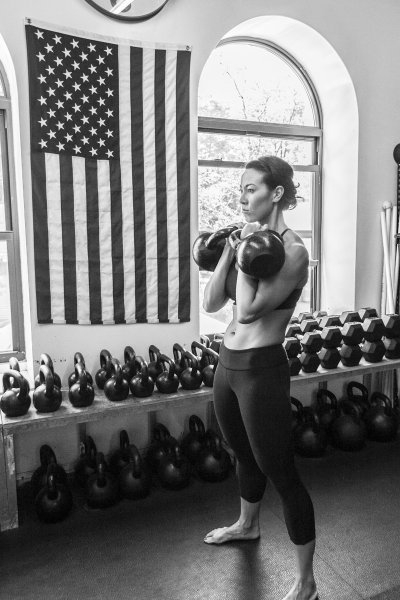How to Get Real About Change
by Annie Vo, RKC Team Leader, PCC Instructor
Photography: Alex Mouganis
When you first started training, gains seemed to happen overnight. Your energy level went through the roof, you looked better in your clothes, and you might have even felt virtuous about eating more vegetables and drinking more water. You started thinking that you looked good for a change! At this stage, you showed up for your workout, threw down, and left the gym feeling better than when you arrived. Depending on the intensity of your training, this period of rapid change might have been brief, or it might have continued for several years.
But, aches and pains eventually creep in, and PRs become distant memories. Many refer to this experience as "plateauing", in reference to a flat, unchanging, horizontal plane. In this state, you stop making gains. Whether you’re doing the exact same workout over and over again or are switching up your exercises, there’s no noticeable change in your fitness. And even worse, your range of motion shrinks, your recovery times between lifts get longer, and you start developing limitations. On any given day, something is hurting, aching or you may even be injured. Clearly, something needs to change.
Repetitive movements of any kind create friction. When the wheels on a car turn, they create friction that gradually wears down the tire treads. To counteract this effect, and to get the most use from a set of tires, it is important to rotate them through different positions on a car. Similarly, we must use balanced movements and volume along with
recovery practices in our training. Barring extensive rehabilitative surgery, we only get one body.
Here’s how you can get real with your training and lifestyle changes:
1. Set Measurable, Reasonable Goals
Because it is purely objective, goal setting is arguably the most important part of your self-assessment. Setting a measurable goal gives you a starting point—and remember, there is no perfect place to start. Where you start will most likely be completely arbitrary. Your goal should be measurable and NOT susceptible to persuasion, emotions, beliefs or interpretations.
But, let me be perfectly clear—the real goal is too start the process of change.
2. Keep a Daily Log
Yes, I know that every trainer wants you to keep a journal. But consider this: by
logging your habits, you are communicating information to yourself. You can then respond to that information.
Write down everything you eat, drink and DO. You can even log how many hours you sleep. The more you desire change in your life, the more information you will record. If you are unwilling to record anything (or very little), then your drive to change is weak. This is not a judgement of your character or an indictment of your honor, but if you are unwilling to understand your habits then you simply do not desire great change. In other words, if you are covering your eyes with your hands, it’s obvious that you do not want to see.

Photography: Alex Mouganis
3. Learn to Care Enough
All these recommendations are based on the assumption that you want to know the truth of your situation. This would mean that your interest in knowing why your results are undesirable is STRONGER than your need to be right. By considering the possibility that you may not be doing things correctly, or that what you are doing no longer works, you will open up the opportunity for real change. If so, your lust for truth is so great that you would happily accept—or even invite—the understanding that everything you thought or did before this point might have been wrong. Do you really want to know the truth?
Chances are, you’re not doing everything incorrectly and many of your thoughts have not been delusional. With that small comfort, you should be confident to examine the thoughts and behaviors which could be impeding your results.
4. Actually Read Your Log
Most people I know keep a log. They write down what they did today, then they throw it in their backpack. They feel self-righteous for doing what every other blog tells them to do, but then they never actually read their logs. For your log to be effective, you must synthesize the information. Making sense of all your information can be tricky, but you can start by looking for "big picture" trends. For example, do you find yourself feeling tired during workouts after you’ve only slept four (or possibly ten) hours the night before? Are you eating huge meals (or perhaps very little) before your best lift days? Are you working out hard several days in a row, or not lifting for days at a time?
Now that you have some information about your habits, look for the larger cause-and-effect relationships within the data. At first, you might not see any obvious connections. If that’s the case, keep logging. Trends will appear over time. Your job is to see those trends while free of personal judgment.
5. Be Prepared to Adapt
Now that you have assessed the big picture, it’s time to scale it down. Start with one thing you can change today, and choose something that you can actually do. Write a new program or have a coach write one for you. Modify one meal a week to see if that changes your energy for your big lift. Sleep one more hour the night before or after your toughest workout. Lay off all the booze or perhaps indulge in one more. It may seem like all these changes must happen simultaneously for progress to occur, but trying to change everything at once can sometimes actually prevent real, sustainable change.
6. Understand that Everything Has a Cost
For everyone who says, "I work a full time job, I have kids and a wife, I don’t have the time," it’s important to understand that yes, it takes time to record habits and behaviors. And it takes even more time to record additional details. A workout also requires time. Everything in this life has a price; you must choose your level of involvement.
If your overall goal is to improve, you will need to become more self-aware. If you take hold of your success, you will ultimately be rewarded with something greater than chiseled abs or a sub-3 hour marathon time. This is because you will have needed to develop personal accountability, the highest form of evolution.
 Annie Vo is one of New York City’s most successful and sought-after personal trainers. She has worked with clients from backgrounds and disciplines, including athletes, celebrities and everyday professionals. Annie Vo is known for her no-nonsense training style and minimalist philosophy, as well as her talent for bringing out the best in everyone who crosses her path.
Annie Vo is one of New York City’s most successful and sought-after personal trainers. She has worked with clients from backgrounds and disciplines, including athletes, celebrities and everyday professionals. Annie Vo is known for her no-nonsense training style and minimalist philosophy, as well as her talent for bringing out the best in everyone who crosses her path.
Ms. Vo has been featured in The New York Post, NPR
and Mademan.com. In addition to her numerous training certifications, Annie was appointed as a Team Leader in Dragon Door’s prestigious RKC (Russian Kettlebell Certification), the world’s premier kettlebell certification. A diverse and complex talent, Annie holds a bachelor’s degree in philosophy from Columbia University in New York City and is a renowned classically trained musician. Learn more about Annie at www.dragondoor.com/annie-vo/
Back